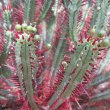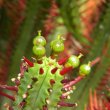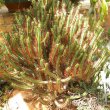Euphorbia enopla var. enopla
| Botanical Name | Euphorbia enopla var. enopla |
|||||||||||
| Family | Euphorbiaceae - The euphorbia family. |
|||||||||||
| Pronunciation | yoo-FOR-bee-uh en-OH-pl-ah |
|||||||||||
| Common Name(s) |
USA: Pincushion Euphorbia
|
|||||||||||
| Plant Group |
|
|||||||||||
| Plant Size |
|
|||||||||||
| Position |
|
|||||||||||
| General Information |
|
|||||||||||
| Specific Information | Euphorbia enopla is a succulent shrub, much branched from the base and profusely covered with stout red spines of up to 15 mm in length. This is one of the most attractive of the euphorbias. The green, grey-green or bluish-green, ribbed branches are about 3 cm in diameter with the decorative spines tightly arranged in rows along the ribbed edges. The stems often branch out towards the upper section forming a candelabra-like effect. Leaves are very small and remain only briefly on the plant before falling off. The male and female cyathia (flowers) are found on separate plants, the male flowers being yellow and the female flowers reportedly dark red (needs to be verified). This plant has been known to survive light frosts of short duration but is unsuitable for areas with heavy, regular periods of frost. Suitable for USDA Zones 9 to 11. As with most Euphorbias, when a plant is cut or damaged it exudes a thick, white, milky, latex-like sap. This sap is poisonous and may irritate the skin. It is very sticky and difficult to remove. Take extreme care not to get any in your eyes or mouth. |
|||||||||||
| Ad Break | ||||||||||||
| Flowers | ||||||||||||
| Description | small cyathia (pseudo-flowers) at the ends of branches on short stems |
|||||||||||
| Season |
|
|||||||||||
| Colour |
|
|||||||||||
| Growth Rate |
|
|||||||||||
| Plant Uses |
|
|||||||||||
| Distribution and Habitat | in the Eastern Cape in the Noorsveld near Jansenville and in arid to semi arid Karoo, in sand and stony soil |
|||||||||||
| Planting Suggestions | The most important requirements for growing Euphorbia enopla are bright light and very well drained soil. Plant in a sunny spot where it will get all day sun or just a little daily shade, in soil that is well drained - plant in a raised mound if the soil is likely to be a bit moist. Water only when the soil is completely dry. Avoid watering in winter. The plant is attractive in a container with the added advantage that it can be protected during inclement winter weather and returned to a sunny spot from spring to autumn. To propagate from seed, make a mixture of equal parts of perlite, coarse sand and potting soil, saturate with water and drain well, then scatter the seeds on the surface. Press down lightly and sprinkle only enough soil to anchor the seeds, keep them from drying out and prevent them from blowing away. Place the tray in a warm, protected, bright but shaded position. Spray lightly with water every second day. Keep the seedlings in the pot or tray until they have established a good root system and have grown to a sturdy size. To propagate from cuttings, remove an offset, wash the cut end under running water to remove the latex and let it dry for a week or so, letting the wound heal. Cuttings planted too soon easily rot before they can grow roots. Place the cutting in the same mixture you would use for seeding, or any well drained sandy soil. Do not over water. Leave until well rooted. |
|||||||||||
| Medicinal Uses | No data found. |
|||||||||||
| Ad Break | ||||||||||||








Discuss this plant
Share knowledge, ask a question or give an experience.